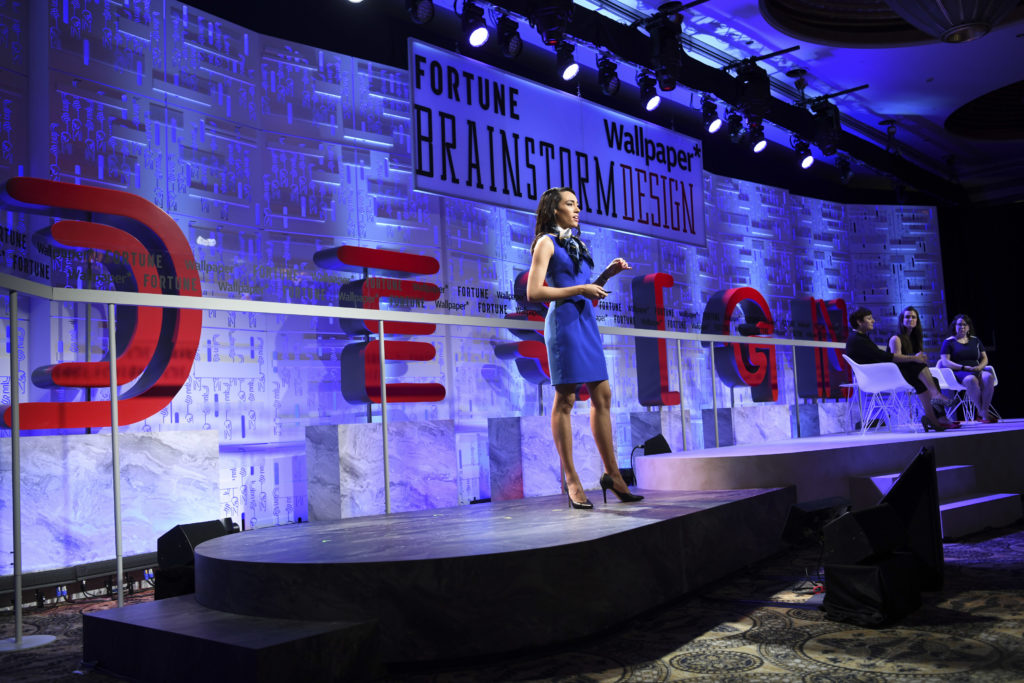Morgan Mercer thought she’d seen and heard everything growing up as a biracial woman in the South. Her father is an ultra-conservative Republican Trump supporter; her mother a liberal Democrat—two opposing perspectives that would come to shape her worldview. “I’d always hear, ‘Oh, your hair doesn’t smell like a black girl’s hair,’ or, ‘Oh, you act so white,’” Mercer recalls of her school-age years. She never questioned whether those statements were okay, or what they meant. “You don’t know it’s wrong. It’s just what you know.”
Still, Mercer left college open-minded and understanding—at least that’s what she thought. It wasn’t until traveling abroad in Italy, where she met a friend in Cinque Terre, that she realized she harbored her own biases. “In passing, I made a really ignorant comment about immigration,” says Mercer. “I was frustrated because, in Italy, people sell these bracelets on the street; some will literally walk up to you and put the bracelet on your wrist. I was annoyed. I said, ‘Why don’t they all just go back to their own countries and get a job there?’” Her friend, whose family had immigrated to Sweden from Ethiopia, froze. “The air was tense, and the whole energy changed,” Mercer recalls. “She said, ‘I can’t believe you would say something so ignorant, because I have so much respect for you. I have aunts and uncles who died immigrating over; you have no idea what people are escaping.’”
It was the moment that changed Mercer’s life. “You don’t take that experience, and say, ‘Well, I’m sorry,’ and expect everyone to move on.” Mercer did a lot of soul-searching, asking herself: Why is this my belief system? Why would something like this ever come out of my mouth? Where do these feelings and this identity stem from? She realized so much of a person’s identity is informed by their environment. “When we grow up in a certain way, we don’t question what we believe, or what we think, or how we feel,” she says. Mercer set out to recreate the exchange she’d experienced with her Swedish-Ethiopian friend for other people, and as the founder and CEO of Vantage Point, a platform that uses virtual reality to drive empathy, she’s doing just that. To date, Mercer has raised $3.75 million, recently closing a $2.25 million seed funding round—one of only a handful of minority women to have raised over seven figures. In a moment where issues like racial inequity and sexual harassment have reached critical turning points, the 26-year-old entrepreneur and thought leader is ready to make her mark.
You had a life-changing experience that prompted you to create a better understanding of systemic issues. How did you come up with the idea for the company?
When that experience happened with my friend, immediately my mind went, how can I take a family member, friend, or someone I grew up with and give them the exact same experience? I realized bias, racism, harassment, gender inequity, etc., have all gotten better—they haven’t gotten worse—we just aren’t where we need to be. I spent the next four years being really obsessed with the problem and befriending a ton of subject matter experts. Eventually, I was sitting at a thought leaders’ dinner after a TED Talk, with the speakers, who were talking about gender inequity. No one could identify [the right] moments to intervene [during a sexist conversation] or what to say if they could. When people identified that they could do something, it was way too late. I just remember thinking, this is crazy.
Along the way, I had decided that technology really drives a lot of the apathy that we feel toward the world, and my mission was to increase empathy by reducing barriers toward understanding using technology. A week after the TED talk dinner, I came up with the idea for the company, which was pre-#MeToo in October 2016. Almost four years later, we’re now a company of 15 employees.

For those who don’t know what Vantage Point is, can you tell them what exactly you’re doing?
Vantage Point leverages the power of virtual reality and other formats of emerging technology to really communicate the contextual nuances of problems related to harassment, diversity, equity, and inclusion; and in the future, more broadly, soft skills training. Instead of explaining a feeling, because feelings are deeply subjective and deeply steeped in personal context, we will immerse you in a scenario and use photo-realistic characters. So instead of being at your office at your workplace [during sexual harassment training], we immerse you at an office party, or in a conference room, or eating lunch with a colleague. Then we’ll introduce you to photo-realistic characters using invasion of personal space, tonality, gaze—the contextual nuances that actually make up the majority of things like harassment and diversity bias problems. We will train people around their comprehension gaps or what they don’t realize they’re doing wrong. Basically, it’s a way to build empathy and a relationship to a problem in a way that’s actually tangible and able to be grasped.
What did you do early on to get things going?
From an actionable perspective, the advice is always to find mentors and advisers. But when you are starting a company, there’s this fear around sharing a new concept. There’s almost like a questioning of self; there are other people questioning you. If it’s a really far-out-there idea a lot of people will tell you, “You’re crazy.” Literally, the first person I told about this idea was like, “Great. So what is it?” I was like, “Exactly what I just told you!” I believe in taking radical chances, meaning the worst thing that’s going to happen is someone is going to think you’re crazy or tell you no. I think of it like trick-or-treating: if you knock on enough doors, someone will give you candy or 10 minutes of their time [laughs.] You just have to knock on every single door. If people think you’re annoying, who cares? I think annoying is just this construct we mentally have.
I didn’t know anything about the [VR] space, and I think the most important part of building something is understanding what it is and how you’re going to build it. So I created a list of 100 women in the VR industry who were considered thought leaders. I reached out to them all on LinkedIn and asked for 10 minutes of their time. I created a spreadsheet around it, where the columns would auto-highlight if it had gone past three days of me reaching out. I signed up for LinkedIn Pro and would ping them every three days. I’d say, “It would mean so much to me if I could just spend 10 minutes learning from you.” I did that for any sort of large Fortune 500 that had an innovation arm, or any nonprofit that did work around sexual assault or domestic abuse. Then, I would create very, very specific questions to a person’s role and skill set. I’d treat it like a “mini mentor” moment, with the goal being to learn as much as I could about what they knew in a 10-minute segment. I took extensive notes. I would write up word-for-word everything they would say, and then I filtered it in a Google Drive so I could come back to it later.
I believe in taking radical chances, meaning the worst thing that’s going to happen is someone is going to think you’re crazy or tell you no.
Then I was crazy and decided to believe in myself. I quit my job at another startup, moved across the country to California, and moved in with my stepdad. All of a sudden, I had all this free time on my hands. I could focus on my company all day, not just during the night, and that felt very liberating. Looking at it through the lens of taking every single opportunity you get, I was applying to everything. I was looking for grants, I was looking for programs, I applied to a ton of accelerators. I was thinking how can I build my network? Are there companies or nonprofits I can partner with that will fund a portion of this? I had a spreadsheet with a tab for every single thing: grants vs. companies vs. nonprofits vs. investors vs. accelerators. I’d track my progress and apply to 10 or 20 a day. I did that for a month until I got into an accelerator program. Meanwhile, I was doing press pitches.
What?! How do you have the brain space?
I don’t know! I love automation and I love spreadsheets if you can’t tell! What I did was go online and find web-scraping tools. I basically would scrape articles that would cover similar things, like technology or women in tech. I’d scrape the email address, put it into a CSB file and use mail merge, and send out a press pitch. By the time #MeToo happened, it was a perfect alignment. I’d networked and met with dozens of thought leaders in the space. I had applied to a ton of programs, we were actively being considered for different accelerators, and at the same time, we started getting some coverage. It was a snowball effect where everything started to happen at once in December 2017.
A lot of the questions I’ll get are like, “How do you find your first customers?” I used my friend’s CrunchbasePro account and filtered through looking for all companies that were 10-50 employees, because the smaller the company, the easier it will be to sell [our product to]—they have fewer stakeholders they’ll have to work through. I pulled that list from CrunchbasePro and I sent an email to HR at all these companies. It’s just thinking about scrappy ways of reaching out to people. Don’t underestimate the power of having passion and a purpose. People respond to passion and purpose, so make sure that’s clearly communicated. Don’t be too salesy; talk about what you’re solving and why you’re solving it.
From the personal or mental side, how did you prepare yourself for founding a company?
When I first started my company, I was so embarrassed to tell anyone, because I knew no one would understand what I was doing. You then face this thing where you’re alienated from the world because no one understands what you’re doing. You don’t want to talk to anyone because you want to protect your idea. And you’re scared, because you know you have to share it for your idea to grow. I ended up tripling my meditation, affirmation, and visualization techniques. I had to do a lot of work around mental reframing—things like, “My worth isn’t externally validated; even if these people don’t believe in it, it’s completely okay. They don’t have to see it. For me, it’s this long journey, this long vision.” I also had this really great support system. One of my best friends, Jess, I would text her. She’d just say, “Keep working. Stay focused. Don’t worry about what people think.” You have to build up mental strength, because even people who have good intentions for you, if you tell them an idea and they’ve never heard it before, they will be like, “What are you doing?” You need to build mental resilience early on, and then keep pushing through it, because if you don’t, that will become a bigger burden than completing the actionable steps themselves.

Where did you get the early funding for Vantage Point? What were your initial costs?
I was working at a startup and was seriously underpaid, but I loved the company, the team, and the flexibility to work remotely and travel; it was a worthwhile trade-off for me. But I was really broke. I had maybe $2,000 in my bank account, and $1,000 or $2,000 in Robin Hood stocks. I had to be very, very scrappy to scrape together any savings. I quit my job, found someone to take over my lease, got rid of all my furniture—didn’t even sell it because I moved in like one week. I put all my stuff in boxes and shipped them across the country on a Greyhound bus, which cost like $300. I could not afford an expensive move. Moving to California and into my stepdad’s was a pivotal resource for me. He said, “Come stay, you’ll figure it out. Trust your journey.”
I was working from the living room for the first few months, keeping my costs low. I would try to take all my meetings from my phone or Zoom, and try to stay very central to my stepdad’s place. I’d go to Trader Joe’s, go grocery shopping, and be very practical with my expenses. As I was starting to run low on money, coming into month two, at that point my stepdad would ask about whether I was going to get a job. I applied to every accelerator I could, including the one I eventually got, which came with a small investment of several tens of thousands. On the company side, I was taking meetings with prospective customers, I was taking meetings with prospective partners, but I had no team, partners, or proof of concept. WhenI got accepted into the accelerator program we built out a true MVP [minimum viable product]. On another note, I also needed a lawyer so that we could incorporate the company; the company needed to be incorporated before it could take any money, including the investment from the accelerator. I needed to find a lawyer, and I needed to pay for it myself. I asked my real dad. We hadn’t always been on the most friendly terms, but I reached out to him. He asked me if I was becoming an activist [laughs]. To my surprise, my dad said yes. I ended up giving both my dad and stepdad equity in my company later. It felt like the right thing to do.
So, we incorporated the company, took the accelerator program’s money, which was kind of like a preseed, and then we leveraged that to build out a prototype that we pre-sold into companies. Again, just being scrappy. How can you make one equal one hundred, not one equal one? We pre-sold [Vantage Point] into companies, and then we used the early traction we got from pre-selling when we had no product to raise our actual pre-seed round—$1.4 million—and then we hit some early milestones, and raised our seed round most recently from a really great group of investors.
What are the hardest parts of pitching your company to investors? Did the expectation of pitching VCs match the reality?
The interesting thing about fundraising is founders are so scripted; but it’s not about pitching, it’s about storytelling. That was a really interesting shift for me to make. You have to understand that the investor across the table for you is someone you’re going to work with for the rest of your company. You want to get to know them. You want to understand what their needs are: what is the investor’s interest? What is the investor’s strength? Can the investor add value to your company? What is the fund focused on? What is the fund’s sweet spot? What are the spaces the fund is watching, or really vested in? What are the spaces they’re less interested in, but would potentially make an investment into?
Founders are so scripted; but it’s not about pitching, it’s about storytelling.
The way I approach pitches is that I have a general flow, but I do it as a linear storytelling format. I’ll tell a story, incorporate external time pressure—because investors, if given the time, will drag their feet to close. But you can never put the pressure on them to close! So you need to incorporate some sort of external time sensitivity, like closing a contract, an upcoming funding announcement, or whatever it may be. It’s literally a storytelling technique, right? So, as you walk them through your arc (“here’s the problem, but oh look! There’s this bright, shining future, here’s the solution”), you are also tying it back to understanding your audience, what they’re interested in and what their value proposition is. Then, make it conversational at the end.
It is hard for women to get venture capital funding, especially women of color. The statistics are grim. Did that factor into your approach to pitching at all?
I’m not going to lie, bias is real. I’ve had meetings with people who would say things that were definitely not appropriate. I’ve had investors ask me my age in deal or pitch meetings. I’ve had investors tell me I was unqualified and unfit to be a leader for having new-founder challenges that almost all prominent male founders have and are consistently overlooked for having. I’ve had investors give me feedback on my “communication style” when passing on a deal, which is one of the most common displays of sexism. I’ve been told not to negotiate on contracts as it would reflect negatively on how the other party would perceive a working relationship with me. I once had an analyst at a fund, when I wasn’t raising, DM me on Instagram and ask me if I was looking for a boyfriend or an investor. I had an investor tell me that “he was free to meet for a deal flow pitch meeting any time on Friday after 9 p.m. when he was done with dinner and drinks, and ‘99 percent of the time he goes home alone.’” This investor’s investment was the predictor for another investor’s investment, who had already committed but wouldn’t come into the round unless this one did.
I’ve adopted a “selectively delusional” mentality where I now call people out on things in the moment and then forget it happened, so it doesn’t impact me psychologically or I’d never get anywhere. Also, there is so much sexism—and as we can blatantly see right now, racism—that I’ve realized most people who have operated in these Old World Orders for so long will have some sort of transgression. I meditate and have compassion for the fact that most people are generally just ignorant and not all are truly bad people. Most of the time, when I call people out, the investor will apologize or take accountability. But of course, I’ve also had many times where they haven’t or have made excuses.
I think that as a female and as a minority, your mission for your company—and for passing the baton forward and being part of the change—has to be so much stronger than whatever you will face in meetings. It really comes down to finding strong allies that support you and have the same mission, who see past bias and gender inequity.
Do you look for value alignment when you are seeking investors? Because it’s not just about the money.
One would assume because I was female and a minority, I should be going after female and minority investors. But when you look at the statistics, .06 percent of capital goes toward Black women. It’s ridiculous. When you look at the number of Black, female-founded companies who are trying to raise capital vs. the number of VCs that specifically focus on investing into female-founded, female-backed, or minority-founded companies, the two numbers just don’t align when you look at the overarching ecosystem in terms of control of capital, investor focus, and profile breakdown of founding teams. Initially, I thought I’d pitch other female and minority investors and I’d have better success, but I realized numerically that wouldn’t be the best path forward because there are so few women and minorities controlling capital. I realized that our message ultimately ended up resonating with a different profile: men who not only wanted to back a great company, but also support a mission or a cause within the realm of a space they’d seen a problem in. We have a ton of great male allies on our cap table, which was surprising to me when I actually looked at it the first time around, because it was guys who were like, “Yes, I totally see what you’re doing and see the issues coming out with #MeToo.” “My wife has had problems with this; I see how much our harassment training sucks. I want to do my part.” So, that was an interesting realization for us.
I've had investors ask me my age in pitch meetings. I've had investors tell me I was unqualified and unfit to be a leader.
But it goes two ways; you have to work with these people for a long time. One problem I think founders run into is not setting boundaries and expectations. Investors get really passionate and excited; they want to jump in the weeds and build it with you. But if you’re not setting boundaries and expectations with how you engage, it can quickly become an issue—especially with the more investors you bring on. Sometimes, I get a feeling of, well, I don’t really know if I want to work with this investor anyway, and then you think, I don’t really care if they pass.
Did you ever pass on the money or working with someone?
There was one investor, actually, recently; it was an angel investor. I’ve never left a meeting before, but I told him his thesis wasn’t a fit for our company and our values were misaligned, and in the best interest of his time and my time, I felt it was best to end the meeting. Maybe I’m a little bit California in the sense that I believe you have to have good energy with the people you are involving in your passion. So if ever I’ve felt we were misaligned or the pitch just wasn’t hitting, I would maybe not be as aggressive on the follow-up or not be as engaged in trying to get them to invest. And there have been times, like the ones I just referenced, where I’ve said, “It’s not a great fit.”
The other thing is, if a dynamic you don’t like is present in a first meeting, it’s not going to change. It’s only going to stay the same, or exacerbate. You have to think about the mental overhead, the mental burden. As a founder, you need to be completely focused on building your company, and if you are focusing your energy on managing a relationship or figuring out how to communicate something that in any other world would be a minor detail, it’s not going to be in the best interest of your company.
What is one of the most important skills you’ve learned in your time as a founder?
I didn’t negotiate as much as I should have with my accelerator program. I negotiated the investment amount because I knew that we would need more capital. I was one of the only friends in the program who didn’t negotiate the equity. I remember having a conversation with one of the women in the program when I realized my mistake after—just because there is a flat offer, a flat contractual agreement, doesn’t mean you can’t ask for more or negotiate. My assumption, having not negotiated previously, and, in part, because I’m a woman and it’s societally ingrained, meant I didn’t negotiate the equity component. My learning was that just because there’s a standard investment or equity, or a way they’ve interacted in the past, does not mean you can’t ask for more. The worst thing that happens is that they say no. I’ve now learned that negotiations are an expected part of interactions.
So the one thing I’ll say—to everyone, but especially women and minorities—the best thing you can learn how to do early on is to negotiate, and not even just in the context of this, but in everything. I think about the first employees we brought on, their comp packages, the customers we signed, the investors—everything.
What are some things you’ve found particularly hard that you wish you would have known before founding your company?
As a founder, unless you are a serial founder, you have no idea what you’re doing; anyone who tells you otherwise is lying. You have no idea how to build a company. It’s not the same to come from a large corporation, or even being an employee at a large startup. I feel like I’ve spent the last two years of my life just learning lessons. On top of that, I had all these people in my network I wasn’t using, and I don’t know why. The best people to use are former founders who have had successful exits, who were operators. You want to bring those people in—as angels if you can, and, if not, as advisors. But if they’re investors, it’s even better because they’ll work twice as hard for you. In our case, we have some as investors and advisors. Then ask them everything: would you hire someone for this? How would you think about structuring out the KPIs for this program? What platforms are you using? How can you make this process more efficient? Because the way somebody who has built their company to a four-year or seven-year exit—in our case, a four-year quarter-billion-dollar exit or a 10-year billion-dollar exit—the way that person thinks about things will be completely different than how you think. Many of the thought processes they adopted that made them successful are things they worked to learn. So, you can spend the same four to 10 years learning it, or you can learn from someone who has done it before. I look back at our early mistakes, like, why did I hire this person? Why did I bring on this agency? Why did I try to negotiate this like this? Why didn’t I negotiate this more? Why didn’t we have a system set up? If you were using your network and building a network in the right way, you could have avoided so many pitfalls.
As a founder, unless you are a serial founder, you have no idea what you’re doing; anyone who tells you otherwise is lying.
Also, I think there’s something to be said about Imposter Syndrome. I like to talk about it because so few people talk about it. Just the whole feeling of, “What the fuck am I doing?” Every other founder I know, you don’t get excited about hitting a milestone. It’s a stepping stone; you’re like, “Okay, great; we did that, so we can now do this. Let’s move onto the next.” You just don’t get excited! It’s funny, because I was reading about Alexa von Tobel [founder of LearnVest, managing partner at Inspired Capital], and she said the same thing. Everything is a building block. And when that happens, you step into a mindset where you have to do as many things as possible, and work as much as possible, and that is tied to what you believe will make the company successful.
I just went through this exercise with my coach this week, on my birthday. I told her, “I feel like I’ve done so much this year, but I’ve done nothing compared to what I wanted to do.” And my coach said, “You’ve done more in a year than a lot of people will do in a lifetime. What are you talking about, Morgan?” She basically walked me through this thought exercise where at the end she told me, “If you continue to think about things the way you do, you are going to leave a lot of opportunity on the table to make an impact and create change.” She reframed my thinking. She said: “Your greatest gift to the world, or your greatest responsibility, is to find fulfillment in today.” Through that lens I’m not thinking, Okay, I’m going to wake up and spend 30 minutes answering 100 emails, and then spend two hours doing this press thing. It’s: how can I find the greatest sense of fulfillment in today? How can I make the most impact in my hours? When you look at things from that perspective, if you are driven by your purpose and mission, the things you do in a day are going to look drastically different than trying to do the most. It’s a simple shift, but that to me has been really hard. I’m the type of person who will work 100 hours. I will work sun-up to sundown. Nothing is ever enough. I always want to do more, build more, go faster. When you exist in that environment, you don’t build to your purpose and—I wouldn’t say it’s not sustainable, because I hate that term; I think you can sustain anything—but you don’t build to your purpose, and it actually caps out the potential you are able to see in a given situation.
What do you find most rewarding? What is the end goal of Vantage Point for you?
What I saw as rewarding in the early days, I didn’t see it as materially rewarding for building the company. Examples of that were speaking at smaller events that weren’t enterprise-facing, so I couldn’t get customers—but maybe I was speaking at a hackathon, where I would get the opportunity to mentor women. Even though it’s something that internally rewards you and it’s in alignment with your larger mission of why you’re starting the company and what you want to do in your lifetime, it literally sucks the life out of you. You’re so busy and it’s not getting you customers. I still love inspiring other women and minorities, and taking time to coach, teach, and mentor people. It’s something that I find a lot of happiness in, and I love doing it, but it can take time to spend 30 minutes or an hour on a one-on-one format with tons of different people, sending off introductions, answering questions, giving them tips, etc.
The other thing I really actually enjoy is talking to our customers; I love seeing their response. As a founder, you spend so long building something, and you work so hard, lots of late nights, and then you see how customers respond—it makes me so happy to see that. I also love the feeling of doing something you haven’t done before. Like closing a round, finding your first contract, making your first hire, your first senior-level hire, managing out an employee successfully. Anything where you’re learning and growing, and it’s a first, that feeling is so great. Then, looking forward, when we are “successful”—by IPO or exit terms—I look at the ways people I really admire built companies. It’s not just, did I build a company that made a ton of money, but also, am I pushing the needle forward in other ways? Are we finding innovative ways to keep building? Are we always holding ourselves accountable to building the best thing, the best product or service, and not just staying complacent because it generates revenue? How are we ensuring our employees are happy? How are we ensuring we have diversity in hiring practices? How are we ensuring the products we build actually benefit society? Not using technology and data in a way that just benefits our bottom line, but in a way that actually benefits people themselves. That’s what I think about. I want to have a nice exit, but I don’t just want to have a nice exit; I want to feel like I built something meaningful.
How are you moving forward in the COVID pandemic? And how do you see Vantage Point’s role in solving our country’s issues with racism and bias against the Black community?
For one of our clients—and this is something I turned around and offered for all of our clients—we’ve actually modified a training track to speak to current events: COVID-19 and bullying of the Asian population. There have been tons of bad news stories about people assaulting or harassing Asians since COVID-19. The second one is obviously Black Lives Matter, same thing. We’ve modified and adapted the training programming to actually speak to some of the recent events we’ve seen and how racism can show up in the workplace or world as a whole.
I feel like this is a necessary inflection point for a large part of the population to be more aware of their privilege. Unfortunately, this movement alone won’t bring us to where we need to be in terms of self-awareness. We are still going to see a somewhat limited sense of self-awareness for people who are “waking up” during this movement. We had 240 years of slavery and 100 years of segregation, and have only just recently come into a “non-segregated” America—mere decades ago. People are paying attention to George Floyd, but they’re still not looking at America’s issue with racism. They’re still not looking at Breonna Taylor. They’re not talking about the way [Amy Cooper] used the cops to try to instill fear into a black man who asked her to leash her dog at a park. They aren’t talking about how the COVID-19 CARES stimuli meant for minority-owned businesses went to corporations that are majority white-owned and had, in some cases, hundreds of millions in reserves funding. And then, people are not acknowledging that corporations essentially just looted a system that hypothetically should have provided relief to minority-owned businesses in a time of economic distress. We give $1,200 stimulus checks to already broke minority families so they can decide between paying their rent or buying food, then we talk about “looting” at the protests more than the racism itself, and ignore when the “looting” is built into the system to support racism and oppression. The press isn’t covering that the same way. Why? Bias, both from reporters and in the way society views similar issues. It just shows that people commenting on current events don’t truly understand the depth of racism, and how oppression is built into society, and how bias filters the narrative told in the media.
Corporations looted a system that should have provided relief to minority-owned businesses in a time of economic distress.
This problem is insanely complex. It isn’t as simple as telling people to “not be racist,” or be “anti-racist” even. You have to understand the history of oppression, how bias works, how modern-day oppression shows up, and then, on top of that, how current events further reinforce or interplay with oppression, bias, and systemic disparity. Then, after that, we can look at the injustice that stems from it. It’s great America is looking at this as an issue where we need more self-awareness—but this is still just surface level. We need to go deeper. My hope that this will be an eye-opening experience for America to realize their ignorance, be a bit more willing to listen, a bit more self-aware, a bit more dedicated and committed to learning, a bit more compassionate, and maybe ask a few more questions about why there aren’t just as many Black people in the room, or on the news, or at the table. This is a start. But understanding the lake is filled with water doesn’t mean you know how deep it goes. We are nowhere near done in this fight for equal access to opportunity, education, freedoms, and the right to live.
On top of that, certainty is a lie; it’s a mental construct we have, but it doesn’t really exist. It’s when we find safety in patterns, and things that we believe will continue to persist in the same way they have historically. But when you think about it, things are always evolving, whether fast or slow. Periods of uncertainty present so much opportunity. When things change, if you can step out of a fear-based approach—fear of what the economy will look like in two years, fear of whether your sector will fail—and these are rational fears, but if you can silence that part of your brain and choose to look at a situation as an opportunity, you start to see opportunities in the changes. We have actually seen new market opportunities that have come out of everything with the economy and coronavirus, and they would only be possible if we had been looking at the problem from a lens of opportunity. Like recruiting assessments, for example. Firms and technology companies are now having to hire workforces remotely, and with so much of interpersonal communication being expressed via things like micro-expressions and body language, employers aren’t able to comprehensively assess the emotional intelligence of newly-hired employees via a webcam call. This is a great opportunity for virtual reality to be applied to this scenario, as we can leverage the technology in a similar format to assess the emotional intelligence of new hires prior to a company making an offer. We’re also obviously going to extend our harassment and inclusion training modules to include remote workforce training modules to further emphasize harassment in new landscapes—virtually.
Fundamentally, startups have to innovate, and you have to innovate through change. Whether it be self-imposed or it’s forced upon you, your job is to innovate through change and try new things quickly. Always think about the 10 different hypotheticals, like, “If the borders stay closed for the next 10 years, then I will do X.” “If the economy recovers in six months, I will do Y.” This gives you a greater sense of understanding, which is where you find security in actually feeling like you have a grasp on the potential moves you can make. It’s a chess game. Within that, you have a new perspective you can operate from.
If you expect to do the same thing you’ve always done in a changing environment, it just doesn’t make sense. If you look at everything, from diets to the ways that people read to commute styles, etc., it’s always adaptable. You adapt based on the city you live in, your lifestyle, your goals. You have to throw out everything you know, the way you see things, and see it as an opportunity to change for the better.
View this post on Instagram
What is your ultimate goal in terms of building Vantage Point? What do you see as success?
I see a world where we can detect your learning patterns. We can compare you as a person, the actions you’re taking, to similar profiles, companies, industries, and cultures, and actually detect, say, “90 percent of users when taught this additional material showed a 70 percent increase in retention or an 80 percent increase in empathy”. Then, we can actually train people into that by forcing empathy, thoughtful risk-taking, and being self-aware; the skills that are not easy to train, but are impactful to the problems that are pressing to the world and are actually a core component of effective leaders and managers.
I view this as what the future of leadership looks like. It would be great if you could say, “I want to become better at communicating,” or, “I want to become a more thoughtful risk-taker,” or, “More empathetic.” I view that as the future of the platform—having an integrated, holistic solution. Right now, we’ll show companies comprehension gaps or risk areas, but I want us to make very highly accurate suggestions. We could say, “Of other companies within the consumer goods space, of your size, based in New York that had high attrition or low upward trajectory for female promotion, when they implemented X, they saw Y improvements.” Then you can actually track your success.
*This interview has been edited for length and clarity
Jenna Birch is a freelance journalist and author of The Love Gap (Grand Central Publishing, 2018). Her work has been published in The Washington Post, Vogue, Harper’s Bazaar, ELLE, InStyle, Fortune, Man Repeller, and many more. Read more of her work here.






